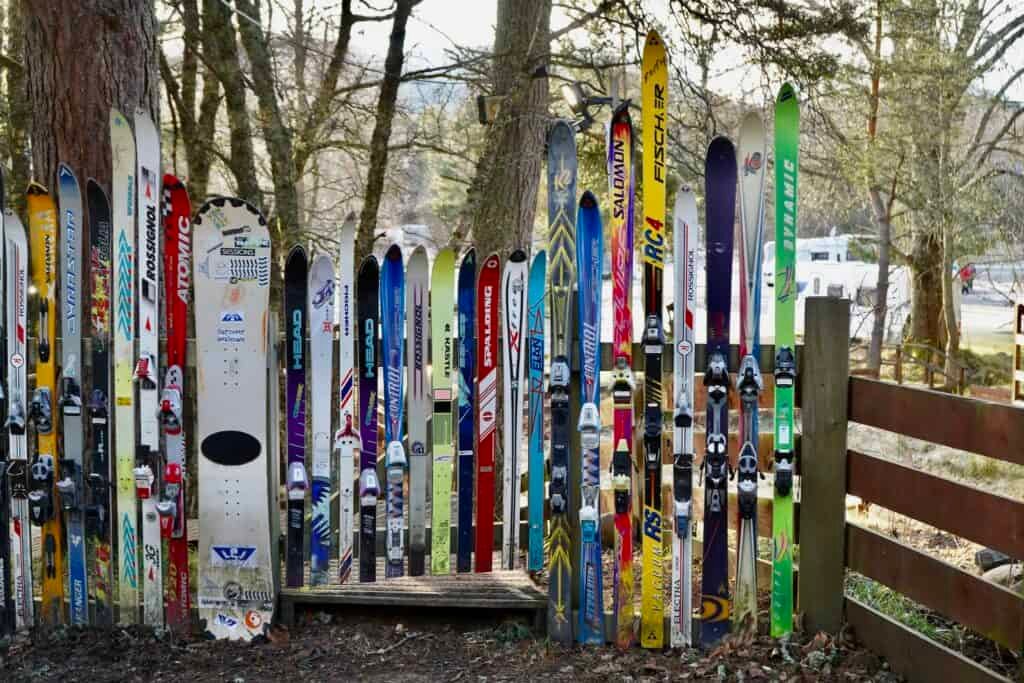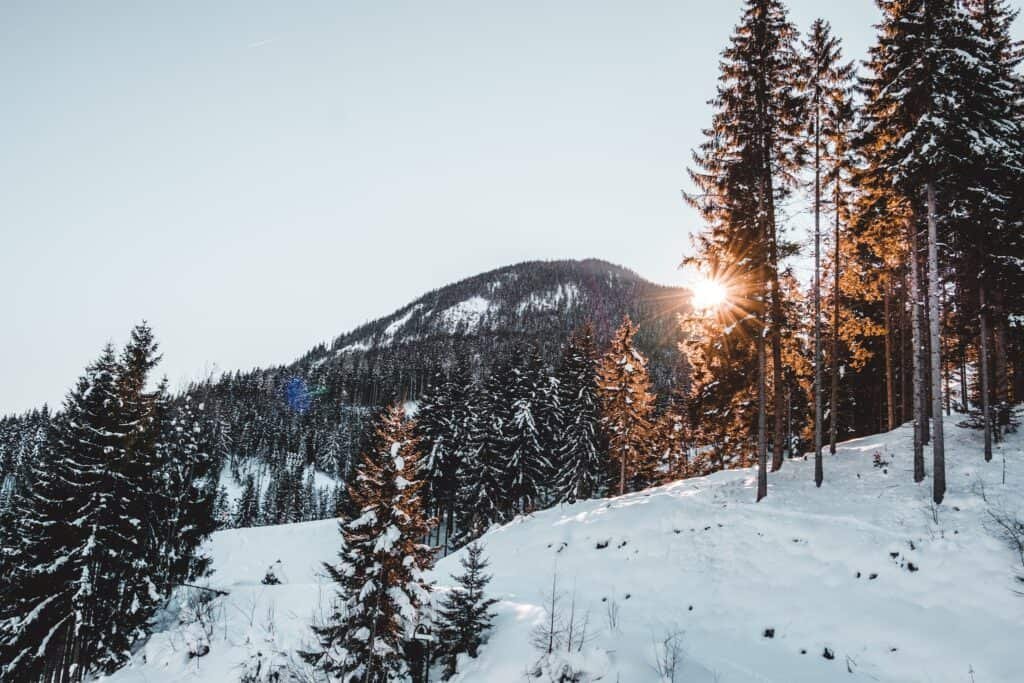How to Stay Warm While Skiing: 8 Insightful Tips

Skiing is a delightful activity that many look forward to during the winter season. However, the cold temperatures on the slopes can be a deterrent if you’re not adequately prepared. Staying warm while skiing is crucial not only for your comfort but also for your safety and overall skiing experience. In this guide, we’ll provide practical and effective tips to help you stay warm and make the most of your skiing adventure, regardless of how cold it gets out there.
In this guide, we’ve assembled valuable tips from trusted sources, enriched by insights from a local expedition guide and personal experiences from snowmobile and ski trips. The goal is to equip you with practical advice for a warm and enjoyable skiing adventure.
Each tip, whether about layering or gear choices, is tailored to ensure you’re well-prepared to embrace the cold and savor every glide down the slopes. For an in-depth look at selecting the right ski jacket for your needs, see our articles on How To Choose A Ski Jacket.
Key Takeaways
- Proper Layering: Dressing in layers to create insulating air spaces and manage moisture.
- Protecting Your Extremities: Ensuring your head, hands, and feet are well-covered and insulated.
- Staying Dry: Keeping moisture at bay to prevent chilling, which includes drying your gear properly between ski sessions.
Basic Thermal Shield
The basics of the most crucial aspects of staying warm while skiing indeed revolve around proper layering, protecting your extremities, and maintaining dryness. These three core principles form the backbone of a warm and comfortable skiing experience, allowing you to tackle cold temperatures effectively.
1. Proper Layering

Layering your clothes not only provides insulation but also allows you to adjust your clothing according to the weather conditions. It’s a versatile approach that ensures you stay comfortable throughout your skiing adventure.
So, how should you layer your clothing?
Start with a moisture-wicking base layer to keep sweat away from your skin. This layer is crucial as it helps regulate your body temperature and prevents you from feeling clammy and cold. Look for base layers made of materials like merino wool or synthetic fabrics such as polyester. These materials are excellent at wicking away moisture, keeping you dry and warm.
Next, add a thermal mid-layer for insulation. This layer helps to trap heat close to your body, providing an extra barrier against the cold. Look for mid-layers made of specialized thermal materials that are designed to retain warmth without adding bulk.
Finally, opt for a waterproof and windproof outer layer to shield yourself from the elements. This layer acts as your first line of defense against snow, wind, and moisture. Look for ski jackets and ski pants made of durable materials, like Gore-Tex, that are both waterproof and breathable. Features like sealed seams and adjustable cuffs can further enhance your protection.
2. Protect your extremities

Your extremities – the hands, feet, and head, are particularly susceptible to cold due to their distance from the core of your body where heat is generated. Hence, safeguarding them is crucial for overall warmth.
Gloves and Mittens
Mittens are generally warmer than gloves as they allow your fingers to generate more heat together. The extra space inside mittens creates a cozy environment for your hands, preventing cold air from seeping in.
However, gloves offer more dexterity, allowing you to easily grip your ski poles and adjust your gear. If you prefer a more hands-on approach while skiing, gloves might be the better option for you. They provide better control and flexibility, making it easier to navigate through the slopes.
Consider the weather conditions and your personal preference when deciding between gloves and mittens. If you’re skiing in extremely cold temperatures or have a tendency to get cold hands easily, opt for mittens. On the other hand, if you prioritize dexterity and control, gloves might be the way to go.
Helmet and Additional Covering
Opt for a thermal hat made from insulating materials such as fleece or wool. These materials trap heat effectively, providing an extra layer of warmth. Additionally, choose a hat that covers your ears to protect them from the cold winds and prevent frostbite.
Helmets are a must-have accessory. A well-fitted ski helmet serves dual purposes; it retains heat while offering protection. Modern ski helmets are crafted with advanced materials making them lighter yet robust. Coupled with additional coverings like neck gaiters, face masks, or balaclavas, you create a shield against cold air intrusion, particularly through gaps between your helmet and jacket. These coverings provide an extra layer of insulation, keeping the chill away from your face and neck.
Socks and Boots
Choose socks made of merino wool or synthetic fibers known for their moisture-wicking capabilities, which draw sweat away from your skin and transfer it to the fabric’s outer surface, keeping your feet dry. It’s advisable to steer clear of cotton as it holds onto moisture, potentially leaving your feet cold and uncomfortable. Ski socks are not only engineered for moisture management but also for breathability, ensuring any excess moisture evaporates easily. Additionally, they are designed to promote blood circulation, aiding in maintaining warmth for your feet while you glide down the snowy slopes.
Your ski boots should fit well, not too tight or too loose, to promote good blood circulation which is crucial for keeping your feet warm. Modern ski boots come with features like insulated liners, heat-moldable shells and liners for a custom fit, and sometimes even heated insoles or boot heaters. Ensure your boots are dry before you put them on. Any moisture in your boots will make your feet cold much faster.
3. Stay Dry

We can’t reiterate much, how opting for moisture-wicking fabrics is a wise choice as they draw sweat away from your skin, promoting evaporation. Your outerwear should be waterproof, equipped with a high waterproof rating, and sealed or taped seams to prevent snow and rain intrusion. Breathability is equally vital; fabrics that allow moisture vapor to escape can prevent sweat accumulation which could lead to chilling.
It’s imperative to start each skiing session with dry gear. Ensure your boots, gloves, and other equipment are thoroughly dried before heading out, using a gear dryer or placing them in a warm, dry area overnight.
Boot gaiters and snow skirts are excellent additions to keep snow from entering your boots and from getting up into your jacket and pants, ensuring you remain dry. Ski at a measured pace to avoid excessive sweating which could lead to a cold, wet experience.
Lastly, regular gear maintenance, including applying water-repellent treatments to outerwear, can significantly contribute to keeping you dry and warm on the slopes.
Additional Tips for Staying Warm
4. Prepare for The Weather

Start by monitoring the temperature before and during your skiing adventure. A quick check on a reliable weather app can give you a heads-up on the day’s expected temperatures, aiding in dressing appropriately.
Wind chill is another factor to be mindful of as it can drastically lower the perceived temperature, making conditions feel colder than they actually are. Awareness of wind chill helps in gearing up adequately to face the brisk winds, especially on open slopes.
Having versatile gear that can cater to varying weather conditions, like layering pieces that can be added or removed as necessary, and carrying essentials like extra gloves, goggles with different lens tints, and a compact weather-resistant backpack to store them, you set yourself up for a more enjoyable and safe skiing outing.
5. Use Warmers

“As an Amazon Associate, I (ItsCherieGonzales) earn from qualifying purchases.” Learn more
Warmers are a convenient and effective solution to combat cold temperatures while skiing. They come in various forms including hand warmers, foot warmers, and body warmers. Here’s a breakdown of how to use them to your advantage:
- Hand Warmers: These are small packets that produce heat when activated. They are great for keeping your hands warm, especially if you tend to have cold fingers. Simply shake them to activate, and place them inside your gloves or pockets for a cozy warmth that lasts for hours.
- Foot Warmers: Similar to hand warmers, foot warmers are activated by shaking and can be placed inside your boots or stuck to the bottom of your socks. They provide a gentle heat that can make a world of difference in keeping your toes warm.
- Body Warmers: Bodywarmers are larger and can be stuck to the inside of your clothing, like your chest or back. They provide a steady heat source, helping to keep your core warm which in turn helps to keep your extremities warm.
- Adhesive Warmers: Some warmers come with adhesive backing, allowing you to stick them to your clothing or even directly on your skin. They stay in place even as you move, providing consistent warmth.
6. Seal the Gaps

Sealing gaps in your skiing attire is crucial to prevent cold air and snow from entering, thus retaining your body’s warmth. Here’s how you can effectively seal gaps and ensure a cozy skiing experience:
- Face Masks, Neck Gaiters, and Balaclavas: These accessories are excellent options to cover your nose and the lower part of your face. They can be pulled up over the nose to provide warmth and protection against cold wind and snow. They provide a snug fit and can be easily adjusted to cover your nose and mouth as needed.
- Ski Masks: Ski masks are designed to cover the entire face with openings for the eyes and sometimes the mouth. They provide complete coverage for the nose, protecting it from cold temperatures and wind.
- Goggles: A good pair of goggles is essential for sealing the gap between your eyes and your ski helmet. They provide protection from the cold wind, snow, and UV rays while improving visibility. Ensure they fit snugly with your helmet to prevent any cold drafts.
- Snow Skirts and Boot Gaiters: Snow skirts inside your jacket and boot gaiters over your boots help seal the gaps at your waist and ankles respectively. They prevent snow and cold air from entering, keeping you warm and dry.
- Adjustable Cuffs and Hems: Look for jackets and pants with adjustable cuffs and hems. They can be tightened to seal off any openings, preventing cold air and snow from entering.
7. Pack warm beverages and snacks

If you plan on staying outside the whole day, packing warm beverages and snacks is a wise strategy to combat cold and maintain energy levels while skiing.
Warm Beverages: Carrying a thermos filled with a warm beverage like hot cocoa, tea, or coffee can provide instant warmth and comfort during chilly ski sessions. Investing in a high-quality thermos that retains heat for several hours is beneficial as it ensures you have a warm drink ready whenever you need it.
Energy-Dense Snacks: In addition to warm beverages, packing energy-dense snacks is crucial for maintaining your energy levels on the slopes. Foods rich in carbohydrates, fats, and proteins provide the necessary fuel your body needs to keep going. Consider packing snacks like nuts, energy bars, cheese, and dried fruits which are easy to eat on the go.
Hydration: Though it might be cold, staying hydrated is necessary as skiing is a strenuous activity that can cause sweat and dehydration. Include some water along with your warm beverages to ensure you stay hydrated.
Accessibility: Having a small, insulated backpack or a hip flask can make it easy to access your beverages and snacks while on the slopes. It’s all about the balance between carrying enough to keep you fueled and warm, without being burdened by too much extra weight.
8. Prepare Your Body Before Skiing

Prior to skiing, warm up your muscles and increase your blood flow with some dynamic stretches and light cardio exercises. Leg swings, lunges, and jumping jacks are a few examples. This helps prevent injuries and improves your body’s heat generation capabilities.
Being in good physical shape aids in heat generation and retention. Regular exercise and strength training improves your cardiovascular fitness, allowing your body to produce more heat effectively. Make sure to incorporate both aerobic and strength training exercises into your fitness routine.
Understanding the Importance of Body Temperature Regulation
When you’re out skiing, your body constantly strives to maintain its core temperature. This process, known as thermoregulation, is crucial for your overall well-being. The human body generates heat through metabolism and muscle activity, but in cold weather, this heat can be quickly lost. Understanding thermoregulation can help you stay warm and comfortable during your skiing adventures.
According to the National Center for Biotechnology Information:
“Disruption of the body’s ability to thermoregulate can lead to temperatures that are too low (hypothermia) or too high (hyperthermia). Slight temperature variations can be reversible with behavior changes and physiologic responses, while extreme variations can ultimately lead to organ failure, coma, and/or death.“
Physiology, Temperature Regulation
Eva V. Osilla; Jennifer L. Marsidi; Karlie R. Shumway; Sandeep Sharma.
Thermoregulation is a complex and fascinating process that involves various physiological responses. One of the key mechanisms is vasoconstriction, where blood vessels in your extremities narrow to reduce heat loss. This narrowing of blood vessels helps to redirect warm blood to vital organs, such as the heart and brain, ensuring their proper function even in cold conditions.
In addition to vasoconstriction, another method your body employs to combat the cold is shivering. Shivering is a reflex action that generates heat by contracting muscles rapidly. This involuntary muscle movement increases your metabolic rate, producing more heat to keep your body warm. It’s like your body’s own built-in heater, working tirelessly to maintain a stable core temperature.
The Science Behind Body Heat and Cold Weather
During cold weather, your body’s thermoregulatory system kicks into high gear to protect you from the freezing temperatures. Alongside vasoconstriction and shivering, there are other fascinating responses at play. For instance, your body may increase its production of brown adipose tissue (BAT), also known as brown fat. Unlike white fat, which stores energy, brown fat generates heat by burning calories. This specialized fat tissue acts as a natural furnace, helping to keep you warm in chilly environments.
Furthermore, your body has a remarkable ability to adapt to cold conditions over time. Through a process called acclimatization, your body gradually adjusts to lower temperatures by increasing its tolerance to the cold. This adaptation involves physiological changes such as improved blood flow to the extremities, enhanced insulation through thicker skin, and increased production of heat-generating enzymes.
Risks of Not Staying Warm During Skiing
Not staying warm while skiing can have serious consequences. Prolonged exposure to cold temperatures can lead to frostbite, hypothermia, and even frostnip. Frostbite occurs when your skin and underlying tissues freeze, often affecting the extremities such as fingers, toes, ears, and nose. The freezing of tissues can cause damage and, in severe cases, may require medical intervention.
Hypothermia, on the other hand, is a condition where your body loses heat faster than it can produce it, resulting in a dangerously low core temperature. This can happen when you are exposed to cold temperatures for an extended period without adequate protection. Symptoms of hypothermia include shivering, confusion, drowsiness, and even loss of consciousness. It is a medical emergency that requires immediate attention to prevent life-threatening complications.
Another risk of not staying warm during skiing is frostnip, a milder form of cold injury. Frostnip occurs when the skin and underlying tissues become extremely cold but do not freeze. It often affects exposed areas such as the cheeks, ears, and fingers. While frostnite is not as severe as frostbite, it can still cause discomfort, numbness, and redness. Taking steps to prevent frostnip is essential to ensure a safe and enjoyable skiing experience.
Conclusion
As we wrap up this guide, it’s crucial to recap the key points that contribute to a warm and enjoyable skiing experience. Staying warm while skiing hinges on a combination of effective layering, safeguarding your extremities, sealing gaps in your attire, staying dry, and being prepared for varying weather conditions. Utilizing warmers, packing warm beverages and energy-dense snacks, and choosing gear with integrated systems to seal off potential cold entry points are additional measures that enhance your comfort on the slopes.
Recap of Key Points:
- Effective layering starts with moisture-wicking base layers, insulated mid-layers, and waterproof outer layers.
- Protecting your extremities like hands, feet, and head is crucial for overall warmth.
- Sealing gaps in your skiing attire prevents cold air and snow from entering, enhancing your warmth and comfort.
- Staying dry is paramount to avoid chilling, which includes choosing breathable fabrics and ensuring your gear is dry before use.
- Being weather-prepared by monitoring temperatures, being aware of wind chill, and adapting to changing weather conditions is essential for a pleasant skiing experience.
Encouragement: Armed with these practical tips and insights, you’re now better prepared to face the chilly slopes while keeping warm. It’s the attention to small details like sealing gaps, packing warm beverages, or having an extra pair of gloves that often makes a big difference in your comfort level. We encourage you to utilize these tips and gear recommendations to ensure you stay warm, allowing you to fully enjoy the beauty and thrill of skiing. Your skiing adventure awaits, and with the right preparations, the cold won’t stand in your way!






